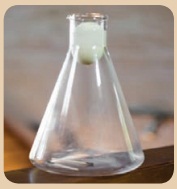Force and Pressure | Chapter 2 | 8th Science - Pressure exerted by Air | 8th Science : Chapter 2 : Force and Pressure
Chapter: 8th Science : Chapter 2 : Force and Pressure
Pressure exerted by Air
Pressure exerted by Air
You all know very well that air fills the space around us. This envelope of air is called as atmosphere. It extends upto many kilometres above the surface of the Earth. All objects on the surface of the Earth experience the thrust or force due to this atmosphere.
The amount of force or weight of the atmospheric air that acts downward on unit surface area of the surface of the Earth is known as atmospheric pressure. It can be measured using the device called barometer. The barometer was invented by Torricelli.
Atmospheric pressure decreases with altitude from the surface of the Earth. It can be measured by the height of the mercury column in a barometer. The height of the mercury column denotes the atmospheric pressure at that place at a given time in ‘millimetre of mercury’. Even if you tilt the tube at various angles, you will see that the level of mercury will not vary. At sea level, the height of the mercury column is around 76 cm or 760 mm. The pressure exerted by this mercury column is considered as the pressure of magnitude ‘one atmosphere’ (1 atm).
More to know
Cooking in a place located at a higher altitude is difficult. Why? At a higher altitude, due to lack of atmospheric pressure the boiling point of a substance reduces. So, water boils even at 80°C. The thermal energy that is produced at this temperature is not sufficient enough for baking or cooking. So, cooking is difficult at higher altitude.
One atmospheric pressure (1 atm) is defined as the pressure exerted by the mercury column of height 76 cm in the barometer. It is equal to 1. 01 × 105 Nm–2.
In the SI system 1 atm = 1,00,000 pascal (approximately). SI unit of atmospheric pressure is Nm-2 or pascal.
Activity 2
Take a conical flask and a well boiled egg, after removing its shell. Place the egg on the mouth of the flask. It will not enter the flask. Now take a piece of paper. Burn it and drop it inside the flask. Wait for a few seconds to burn fully. Now, keep the egg on the mouth of the flask. Wait for a few minutes. What do you observe?

When the paper is burning in the flask, the oxygen present in the air inside the conical flask is used up for its combustion. This reduces the pressure of the air in the flask. The air in the atmosphere tends to occupy the low pressure region in the flask. So, it rushes through the mouth of the flask, thus pushing the egg into the flask.
Answer:
Aim : To realise the atmospheric pressure.
Materials
required: Conical flask, boiled egg, piece of
paper.
Procedure:
(i) Take a conical flask.
(ii) Take a well boiled egg, after removing its shell.
(iii) Place the egg on the mouth of the flask.
(iv) It will not enter the flask.
(v) Take a piece of paper.
(vi) Burn it and drop it inside the flask.
(vii) Wait for a few seconds, let it burnt fully.
(viii) Now keep the egg on the mouth of the flask.
(ix) Wait for a few minutes.
Observation: The egg placed at the mouth of the flask gets compressed and it
falls into the flask, due to the atmospheric pressure.
Inference:
(i) When the paper is burning in the flask, the oxygen present
in the air inside the conical flask is used up for its combustion. This reduces
the pressure of the air in the flask. The air in the atmosphere tends to occupy
the low pressure region near the flask.
(ii) So, it rushes through the mouth of the flask, thus pushing the egg into the flask. Eventually, the egg falls down to the bottom of the flask.
Related Topics